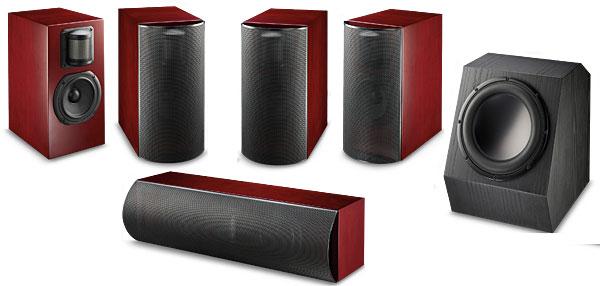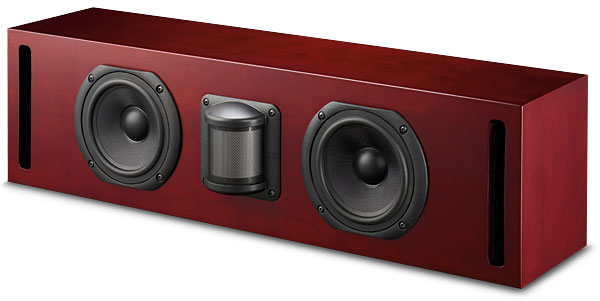Gallo Nucleus Classico CL-2 Speaker System

Shape is destiny for Anthony Gallo Acoustics. The company is best known for its spherical and cylindrical speaker enclosures, made of metal and tough as tanks. But the Classico Series is the first Gallo product to use a plain rectan-gular box—for consumers, the company says, who prefer a more traditional look. Though not as curvaceous as other Gallo lines, the Classico is still available in a beautiful Cherry veneer finish, along with the more staid Black Ash veneer of our review samples. Note that the speakers are sold only through the Gallo Website: roundsound.com. The more conventional construction and factory-direct approach make the Classico models among the most affordable Gallo speakers ever.
Description
The Classico Series—or to give its full name, the Nucleus Classico Series—consists of the CL-1 ($247.50/each) and CL-2 ($397.50/each) monitors, the CL-3 ($797.50/each) and CL-4 ($1,247.50/each) towers, the CL-C center ($599), and a pair of subwoofers, the 10-inch CLS-10 ($699) and 12-inch CLS-12 ($999). All except the subs share similar 5.25-inch polymer-damped carbon-fiber cone woofers. The largest tower has four of them, the other tower and the center have two, and the two monitors have one each. All share the CDT-3 cylindrical tweeter except for the CL-1 monitor, which uses a con-
ventionally shaped fabric dome.
The tweeter used on all but one of these speakers is what’s special about the Classico line. Its full name is CDT-3, which stands for cylindrical diaphragm transducer. Anthony Gallo, who was involved in the design of this third-generation piezoelectric tweeter, is better at describing it than I am, so let’s hear him: “Our piezo film tweeter does not have a conventional voice coil. Instead there is a thermoplastic (Kynar) sheet that is screen-printed on both sides with a conductive silver ink. When an audio signal is applied to both conductive surfaces of the Kynar, the sheet either expands or contracts depending on the signal polarity at the time. When this sheet is wrapped into cylindrical form, the expansion and con- traction cause the cylinder to pulse in and out in all directions evenly and across the tweeter’s full bandwidth.” The resulting half-cylinder has a 180-degree radiation pattern, with excellent dispersion, which I found to be extraordinarily wide horizontally and to a lesser extent vertically. If you’re looking for a tweeter that hits every listener in the room, this is what you want.
While the enclosures may look boxy, they’re smart on the inside. For bass loading, in lieu of a simple port, they use a more complex modified transmission line, which Gallo calls BLAST (backwave linearization and synchronization technology). They’re filled with permeable bags of polyolefin plastic fiber flakes that help to improve the volumetric efficiency of the air in the cabinet. Gallo calls this damping system S2 Technology and says it “tricks the driver into thinking that it is performing in a much larger enclosure.” See our measurements to find out how this strategy worked.
One look at the CLS-10 subwoofer tells you it’s different. The baffle is tilted back to aim the 10-inch driver’s output forward and upward. There’s a crossover bypass if you prefer to set bass management in your receiver (as I do). There’s also a bass boost switch with three settings: 0 decibels, +3 dB, and +6 dB. I never needed it during the demos. The only thing it lacks is internal EQ beyond this pre-configured boost, but now that room correction is standard equipment in many A/V receivers, it’s less needed in subs than it used to be. The internal amplifier is rated at 300 watts RMS.
Associated equipment included a Pioneer Elite VSX-53 A/V receiver, Oppo BDP-83SE universal disc player, Lenovo Win7 laptop playing through a Wadia 121 USB DAC, Micro Seiki BL-51 turntable, Shure M97xE phono cartridge, and Onix OA 21s integrated amp serving as phono preamp. All movie demos were Blu-ray Discs with DTS-HD Master Audio soundtracks.
Radio Gallo
To call the CL-2 and CL-C remarkable would be an understatement. They are certainly different from ordinary dome-tweeter-equipped speakers. Most dome tweeters have wide dispersion, both horizontally and vertically, at the low end of their frequency range but become more directional as the frequency increases. The Classicos’ curved diaphragm produces extremely broad horizontal dispersion (though presumably less so vertically). These tweeters blanket the whole seating area from left to right with highs and upper mids. The treble was broadcast so widely, I came to think of them as Radio Gallo. In surround, with three speakers operating across the front, pretty much any seat on the sofa was a great one: The soundfield was extremely stable no matter how much I moved around. In stereo, even without the center operating, the soundstage was pretty solid. Depending on program material, horizontal shifts between on-axis and off-axis response ranged from minor to nearly undetectable. When my head moved just a few inches, there was no difference at all. Though incredibly detailed, the speakers maintained a high comfort level across all content. They were airy, not steely; revealing, but not brash or etched. The sub also did a fine job, alternating between enormous output levels and scrupulous low-end subtlety when it was called for. What was all the more remarkable was that the speakers achieved these feats at such low price points; hundreds, not thousands, per speaker.
We Need to Talk About Kevin kept me continually stimulated with the tension between the plot-twisted story—about a woman tormented by her psychopathic kid, with Tilda Swinton and Ezra Miller both memorable in the main roles—and the stunning, steadfast consistency of the speakers. Like a star pitcher hurling fastballs, the Classicos exhibited alacrity and control. The CL-C was always a model of vocal clarity regardless of volume level and listening position. It was as timbre-rich as the source allowed but not thin or edgy. Effects as tiny as lawn sprinklers seemed to arc through the air, not overdone but nonetheless mildly startling. Surround effects in particular were almost vivid enough to be distracting. If I were just a civilian, I would have knocked down the surround levels a decibel or two. However, as a reviewer who’s inclined to do things by the book, I stuck with the levels I’d carefully set with a meter. In any event, all this served to enhance the movie’s relentlessly building menace and horror—it really got under my skin.

The score of War Horse features orchestra with solo flute. I could sense the spatial character of the dubbing stage. This epic Spielberg tale was well served by the sprawling horizontal dispersion of the speakers’ tweeter. Rainfall had multiple mud-splattering impacts, for example. Elsewhere, the hum of a vintage car engine vividly conjured the mechanical complexity of metal parts interacting within a metal box. But as much as I appreciated the speakers, it was the sub that had to work hardest, with galloping hooves, thundering cavalries, and heavy-artillery bombardments. For a 10-incher, it was surprisingly powerful, mustering higher and higher output as the story stepped up its decibel count. Even without room correction—which I avoid when reviewing speakers except when it’s built into the sub—the CLS-10 was a manifestly good- sounding sub.
God Bless America is a Bobcat Goldthwait–penned dark comedy about a fed-up guy—played by Joel Murray, Mad Men’s Freddy Rumsen—who guns down reality-TV stars and other people for having bad manners. I should warn you that it ceased to be funny when he took an assault weapon into a public venue. The shots that occasionally interrupted the preachy dialogue were unfatiguing but made less of an impression than the revelatory musical interludes, especially an incisive thrust of Alice Cooper (who is spoken of reverentially in the script) and a honeyed slice of Rosemary Clooney. The speakers were girding for the music demos.
You Are There
Herbie Hancock’s Maiden Voyage came in the form of a 24/192 download from HDtracks.com. This classic Blue Note album called for a mellow, unfussy sound, and that’s what a pair of Classico monitors delivered (using the computer-fed Wadia DAC and my receiver’s Pure Direct mode). The center image was unshakable, which helped the bandleader’s piano and Ron Carter’s bass keep up with trumpeter Freddie Hubbard and tenor sax George Coleman at the sides.
- Log in or register to post comments





































































